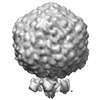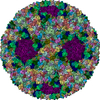[English] 日本語
 Yorodumi
Yorodumi- EMDB-5203: Subtomogram average of epsilon15 using Zernike phase contrast mic... -
+ Open data
Open data
- Basic information
Basic information
| Entry | Database: EMDB / ID: EMD-5203 | |||||||||
|---|---|---|---|---|---|---|---|---|---|---|
| Title | Subtomogram average of epsilon15 using Zernike phase contrast microscopy | |||||||||
 Map data Map data | This is an image of a surface rendered top-view of epsilon 15 phage reconstructed with 50 subtomograms taken with a Zernike phase plate. | |||||||||
 Sample Sample |
| |||||||||
 Keywords Keywords | Phase contrast / cryoEM / electron tomography / bacteriophage | |||||||||
| Biological species |   epsilon15 (virus) epsilon15 (virus) | |||||||||
| Method | subtomogram averaging / cryo EM / Resolution: 32.0 Å | |||||||||
 Authors Authors | Murata K / Liu X / Danev R / Jakana J / Schmid MF / King J / Nagayama K / Chiu W | |||||||||
 Citation Citation |  Journal: Structure / Year: 2010 Journal: Structure / Year: 2010Title: Zernike phase contrast cryo-electron microscopy and tomography for structure determination at nanometer and subnanometer resolutions. Authors: Kazuyoshi Murata / Xiangan Liu / Radostin Danev / Joanita Jakana / Michael F Schmid / Jonathan King / Kuniaki Nagayama / Wah Chiu /  Abstract: Zernike phase contrast cryo-electron microscopy (ZPC-cryoEM) is an emerging technique that is capable of producing higher image contrast than conventional cryoEM. By combining this technique with ...Zernike phase contrast cryo-electron microscopy (ZPC-cryoEM) is an emerging technique that is capable of producing higher image contrast than conventional cryoEM. By combining this technique with advanced image processing methods, we achieved subnanometer resolution for two biological specimens: 2D bacteriorhodopsin crystal and epsilon15 bacteriophage. For an asymmetric reconstruction of epsilon15 bacteriophage, ZPC-cryoEM can reduce the required amount of data by a factor of approximately 3, compared with conventional cryoEM. The reconstruction was carried out to 13 A resolution without the need to correct the contrast transfer function. New structural features at the portal vertex of the epsilon15 bacteriophage are revealed in this reconstruction. Using ZPC cryo-electron tomography (ZPC-cryoET), a similar level of data reduction and higher resolution structures of epsilon15 bacteriophage can be obtained relative to conventional cryoET. These results show quantitatively the benefits of ZPC-cryoEM and ZPC-cryoET for structural determinations of macromolecular machines at nanometer and subnanometer resolutions. | |||||||||
| History |
|
- Structure visualization
Structure visualization
| Movie |
 Movie viewer Movie viewer |
|---|---|
| Structure viewer | EM map:  SurfView SurfView Molmil Molmil Jmol/JSmol Jmol/JSmol |
| Supplemental images |
- Downloads & links
Downloads & links
-EMDB archive
| Map data |  emd_5203.map.gz emd_5203.map.gz | 36.7 MB |  EMDB map data format EMDB map data format | |
|---|---|---|---|---|
| Header (meta data) |  emd-5203-v30.xml emd-5203-v30.xml emd-5203.xml emd-5203.xml | 8.6 KB 8.6 KB | Display Display |  EMDB header EMDB header |
| Images |  emd_5203_1.png emd_5203_1.png | 105.8 KB | ||
| Archive directory |  http://ftp.pdbj.org/pub/emdb/structures/EMD-5203 http://ftp.pdbj.org/pub/emdb/structures/EMD-5203 ftp://ftp.pdbj.org/pub/emdb/structures/EMD-5203 ftp://ftp.pdbj.org/pub/emdb/structures/EMD-5203 | HTTPS FTP |
-Related structure data
- Links
Links
| EMDB pages |  EMDB (EBI/PDBe) / EMDB (EBI/PDBe) /  EMDataResource EMDataResource |
|---|
- Map
Map
| File |  Download / File: emd_5203.map.gz / Format: CCP4 / Size: 37.5 MB / Type: IMAGE STORED AS FLOATING POINT NUMBER (4 BYTES) Download / File: emd_5203.map.gz / Format: CCP4 / Size: 37.5 MB / Type: IMAGE STORED AS FLOATING POINT NUMBER (4 BYTES) | ||||||||||||||||||||||||||||||||||||||||||||||||||||||||||||||||||||
|---|---|---|---|---|---|---|---|---|---|---|---|---|---|---|---|---|---|---|---|---|---|---|---|---|---|---|---|---|---|---|---|---|---|---|---|---|---|---|---|---|---|---|---|---|---|---|---|---|---|---|---|---|---|---|---|---|---|---|---|---|---|---|---|---|---|---|---|---|---|
| Annotation | This is an image of a surface rendered top-view of epsilon 15 phage reconstructed with 50 subtomograms taken with a Zernike phase plate. | ||||||||||||||||||||||||||||||||||||||||||||||||||||||||||||||||||||
| Projections & slices | Image control
Images are generated by Spider. | ||||||||||||||||||||||||||||||||||||||||||||||||||||||||||||||||||||
| Voxel size | X=Y=Z: 4.88 Å | ||||||||||||||||||||||||||||||||||||||||||||||||||||||||||||||||||||
| Density |
| ||||||||||||||||||||||||||||||||||||||||||||||||||||||||||||||||||||
| Symmetry | Space group: 1 | ||||||||||||||||||||||||||||||||||||||||||||||||||||||||||||||||||||
| Details | EMDB XML:
CCP4 map header:
| ||||||||||||||||||||||||||||||||||||||||||||||||||||||||||||||||||||
-Supplemental data
- Sample components
Sample components
-Entire : Epsilon 15
| Entire | Name: Epsilon 15 |
|---|---|
| Components |
|
-Supramolecule #1000: Epsilon 15
| Supramolecule | Name: Epsilon 15 / type: sample / ID: 1000 / Details: The sample was monodisperse / Number unique components: 1 |
|---|
-Supramolecule #1: epsilon15
| Supramolecule | Name: epsilon15 / type: virus / ID: 1 / Name.synonym: epsilon15 / Sci species name: epsilon15 / Database: NCBI / Virus type: VIRION / Virus isolate: STRAIN / Virus enveloped: No / Virus empty: No / Syn species name: epsilon15 |
|---|---|
| Host (natural) | Organism:  Salmonella (bacteria) / synonym: BACTERIA(EUBACTERIA) Salmonella (bacteria) / synonym: BACTERIA(EUBACTERIA) |
| Virus shell | Shell ID: 1 / Diameter: 700 Å / T number (triangulation number): 7 |
-Experimental details
-Structure determination
| Method | cryo EM |
|---|---|
 Processing Processing | subtomogram averaging |
| Aggregation state | particle |
- Sample preparation
Sample preparation
| Buffer | pH: 7.5 |
|---|---|
| Vitrification | Cryogen name: ETHANE / Instrument: OTHER |
- Electron microscopy
Electron microscopy
| Microscope | JEOL 2200FS |
|---|---|
| Temperature | Average: 90 K |
| Specialist optics | Energy filter - Name: JEOL / Energy filter - Lower energy threshold: 0.0 eV / Energy filter - Upper energy threshold: 20.0 eV |
| Image recording | Number real images: 71 / Bits/pixel: 16 |
| Electron beam | Acceleration voltage: 200 kV / Electron source:  FIELD EMISSION GUN FIELD EMISSION GUN |
| Electron optics | Illumination mode: FLOOD BEAM / Imaging mode: BRIGHT FIELD / Cs: 4.3 mm / Nominal magnification: 20000 |
| Sample stage | Specimen holder: Eucentric / Specimen holder model: GATAN LIQUID NITROGEN / Tilt series - Axis1 - Min angle: -70 ° / Tilt series - Axis1 - Max angle: 70 ° |
- Image processing
Image processing
| Details | Average number of projections used in the 3D reconstructions: 50. |
|---|---|
| Final reconstruction | Resolution.type: BY AUTHOR / Resolution: 32.0 Å / Resolution method: FSC 0.5 CUT-OFF |
 Movie
Movie Controller
Controller












 Z (Sec.)
Z (Sec.) Y (Row.)
Y (Row.) X (Col.)
X (Col.)





















